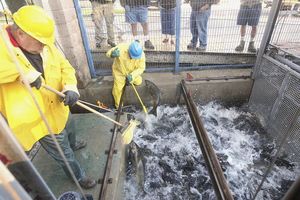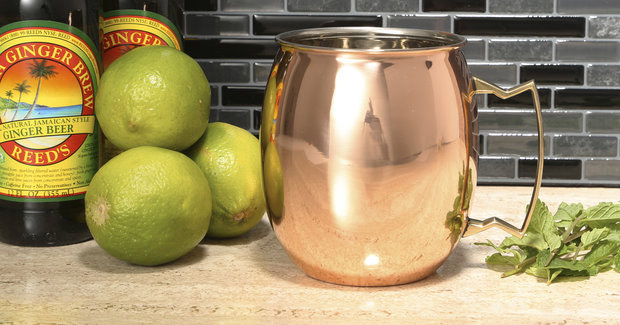
Boardman River weir yielded just half of what they normally see
Above: Record-Eagle/Jan-Michael StumpTerry Whiteford, left, and Jim Morse of American Canadian Fisheries lead salmon into a crate during a harvest on Tuesday morning at the James Patrick Price Fish Trap, Transfer and Harvest Station on the Boardman River in Traverse City.
By MICHELLE MERLIN mmerlin@record-eagle.com
TRAVERSE CITY — Fishermen and environmental officials alike have noticed populations of salmon are scaled back from previous years.
This year Cameron Garst, owner of Showtime Charters, has been more focused on catching trout after what he estimates is a 40 percent decline in salmon in Grand Traverse Bay.
“It has not affected business, but it’s frustrating that I don’t have the salmon fishery I used to have,” Garst said.
Michigan Department of Natural Resources officials noted the same scenario, with fish population numbers sinking below their normal levels.
The Boardman River weir yielded 304 Chinook salmon and 388 coho salmon on Sept. 23, and the weirs on the Platte River passed just under 10,000 coho salmon, all about half of what they typically see, DNR officials said.
“This run does seem to be a little later than we’ve seen in the past,” said Mark Tonello, a fisheries biologist with the DNR. “This year’s run is probably going to be lower numerically, as well.”
The DNR stocks several rivers with fish, which migrate downstream and into Lake Michigan. When the fish mature over three or four years, they return to their river of origin to lay eggs and then die.
The DNR has several weirs, or dams that stop the fish, along those rivers, including on the Boardman River.
“We stock the salmon and they create a very good fishery in Lake Michigan,”Tonello said. “When they return to the rivers, sometimes it is not socially acceptable to have huge numbers of dying salmon lining the river banks, particularly in downtown Traverse City.”
Salmon taken from the weir goes to a contractor, American Canadian Fisheries, which processes the fish for human consumption or to be put in pet food. When the rivers are flush with fish, they give some away for free.
The exact reasons behind the salmon decline remain muddy, but theories abound.
“We’re not 100 percent sure, but we think a lot of it has to do with the food base in Lake Michigan,” said Mark Tonello, a fisheries biologist with the DNR.
Alewife populations were down in 2011, resulting in less food for salmon to eat that year, Tonello said. Since the salmon typically have a three- or four-year life span, the fish in the weirs this year would have been impacted, he said.
Heather Hettinger, a fisheries management biologist for the DNR, said cold water temperatures also could be to blame.
Garst had a simpler answer: the DNR decided to reduce the salmon populations several years ago and the results are showing now.
http://www.record-eagle.com/news/local_news/article_7fa0ca04-ccd3-50d3-839a-4f8369e5f59d.html



